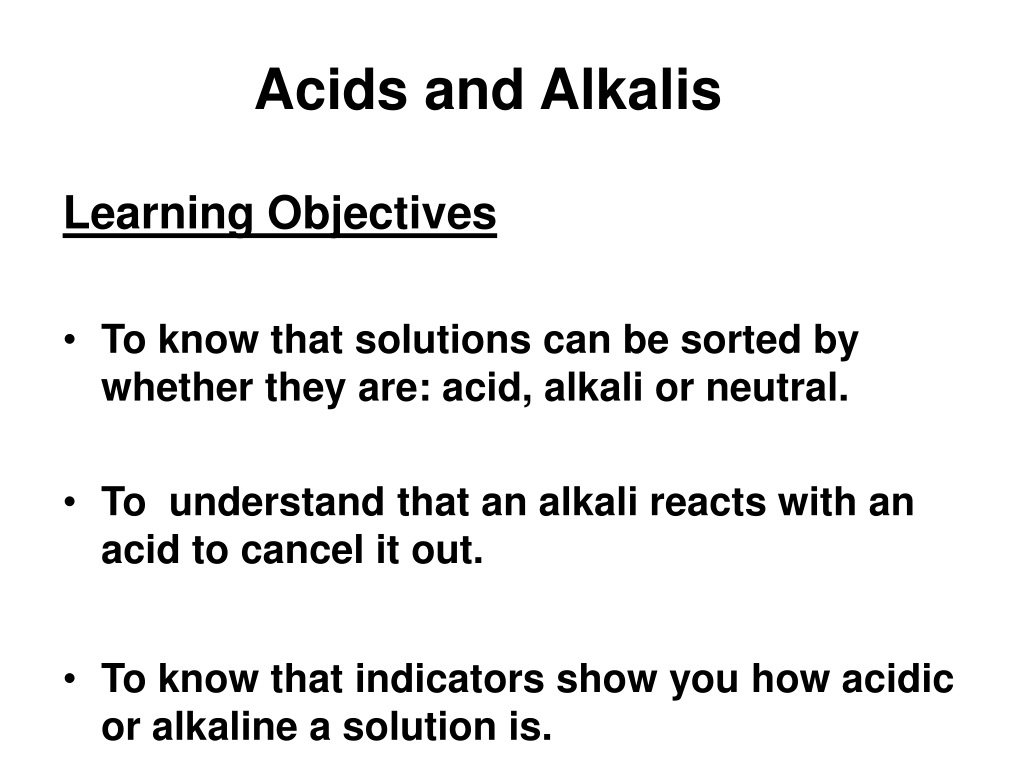

0 likes | 9 Views
Solutions can be classified as acids, alkalis, or neutral based on their properties. Acids have a sour taste, react with metals, and can be found in daily items like lemon juice and vinegar. Alkalis feel soapy, neutralize acids in reactions known as neutralization, and are commonly present in cleaning products. Indicators like litmus and universal indicator help determine the acidity or alkalinity of a solution. Neutralization has various practical applications, such as treating insect stings, indigestion, managing factory waste, and enhancing soil quality for plant growth.

E N D
Acids and Alkalis Learning Objectives • To know that solutions can be sorted by whether they are: acid, alkali or neutral. • To understand that an alkali reacts with an acid to cancel it out. • To know that indicators show you how acidic or alkaline a solution is.
Acids and alkalis When a substance dissolves in water it makes a solution. Solutions can be sorted by whether they are: acid, alkali or neutral.
When the oxide of some non-metals dissolve in water they make an acid. Acids have a sour taste. They are corrosive.
Acids react with metals and carbonates. Metal + Acid Salt + Hydrogen magnesium + hydrochloric acid hydrogen magnesium chloride + Acid + Carbonate Salt + Water + Carbon dioxide sulphuric acid + copper sulphate + water + copper carbonate carbon dioxide
Acids There are many acids present in our everyday lives. Lemon juice contains citric acid, and vinegar contains ethanoic acid. Some strong acids are hydrochloric acid, sulphuric acid and nitric acid. Some weak acids are ethanoic acid, citric acid and carbonic acid.
Neutralisation • Acids and alkalis react with each other. The alkali cancels out the acid in the reaction. This is called neutralisation. A salt is made.
Salts • The salt made depends on the acid and alkali used. • The salt contains the metal atom from the alkali, and part of the acid molecule. The salts of sulphuric acid are known as sulphates. The salts of hydrochloric acid are known as chlorides. The salts of nitric acid are known as nitrates.
Alkalis Many everyday substances are alkalis. They feel soapy. They are corrosive. When the oxides of some metals dissolve in water they make an alkali solution. Alkalis react with acids and neutralise them.
Alkalis Alkalis are present in many cleaning substances in use in our homes. Kitchen cleaners are alkaline because they contain ammonia or sodium hydroxide, which attack grease. Calcium hydroxide and sodium hydroxide are strong alkalis. The most recognisable and common weak alkali is ammonia.
Indicators Indicators help you find out whether a solution is acidic or not. They change colour in acid or alkaline solutions. Different indicators change to different colours.
Litmus Test • Litmus is an indicator. It changes colour in acid and alkaline solutions. • Litmus is red in an acid. • Litmus is blue in an alkali.
Universal Indicator • Universal indicator changes colour in acids and alkalis. Neutral ACIDS ALKALIS Its colour shows the strength of an acid or alkali.
The pH scale 1 – 6 Acids 8 - 14 Alkalis 7Neutral
Applications of Neutralisation • Insect Stings Bee stings are acidic and can be neutralised with baking soda (bicarbonate of soda). Wasp stings are alkaline and can be neutralised with vinegar. • Indigestion: Our stomach carries around hydrochloric acid. Too much of this leads to indigestion. To cure indigestion, you can neutralise the excess acid with baking soda or specialised indigestion tablets.
Factory Waste: Liquid waste from factories is often acidic. If it reaches a river it will destroy and kill sea life of many forms. Neutralising the waste with slaked lime can prevent this. Soil Treatment: When soils are too acidic (often as a result of acid rain) they can be treated with slaked lime, chalk or quicklime, all alkalis. Plants and crops grow best in neutral soils. More Applications of Neutralisation
This powerpoint was kindly donated to www.worldofteaching.com http://www.worldofteaching.com is home to over a thousand powerpoints submitted by teachers. This is a completely free site and requires no registration. Please visit and I hope it will help in your teaching.